Solitude and Hope: Y'all Come Visit!
Publick and Privat Curiosities: Articles Related to News, Politics, Society, Gay Issues, Psychology, Humor, Music and Videos.March 13, 2006
Gordon Parks: A Memorial

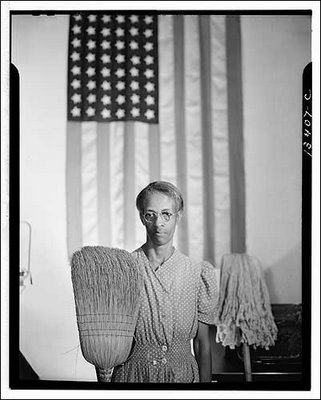
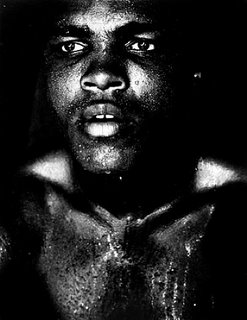


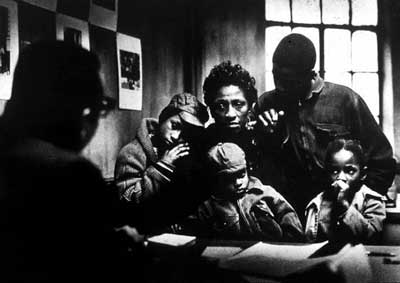
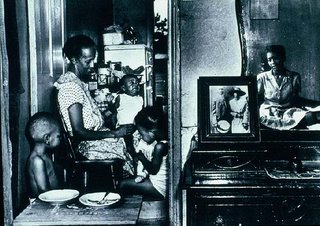

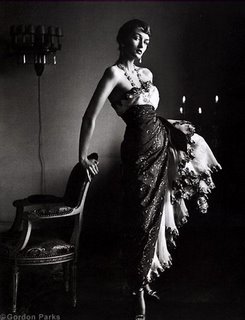


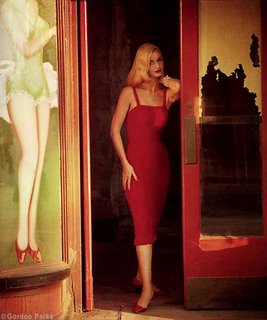


Gordon Parks, the photographer, filmmaker, writer and composer who used his prodigious, largely self-taught talents to chronicle the African-American experience and to retell his own personal history, died on March 7th, 2006, at his home in Manhattan. He was 93.
Gordon Parks was the first African-American to work as a staff photographer for Life magazine and the first black artist to produce and direct a major Hollywood film, "The Learning Tree," in 1969. He developed a large following as a photographer for Life for more than 20 years, and by the time he was 50 he ranked among the most influential image makers of the postwar years. In the 1960's he began to write memoirs, novels, poems and screenplays, which led him to directing films. In addition to "The Learning Tree," he directed the popular action films "Shaft" and "Shaft's Big Score!" In 1970 he helped found Essence magazine and was its editorial director from 1970 to 1973.
An iconoclast, Mr. Parks fashioned a career that resisted categorization. No matter what medium he chose for his self-expression, he sought to challenge stereotypes while still communicating to a large audience. In finding early acclaim as a photographer despite a lack of professional training, he became convinced that he could accomplish whatever he set his mind to. To an astonishing extent, he proved himself right.
Gordon Parks developed his ability to overcome barriers in childhood, facing poverty, prejudice and the death of his mother when he was a teen-ager. Living by his wits during what would have been his high-school years, he came close to being claimed by urban poverty and crime. But his nascent talent, both musical and visual, was his exit visa. His success as a photographer was largely due to his persistence and persuasiveness in pursuing his subjects, whether they were film stars and socialites or an impoverished slum child in Brazil.
Mr. Parks's years as a contributor to Life, the largest-circulation picture magazine of its day, lasted from 1948 to 1972, and it cemented his reputation as a humanitarian photojournalist and as an artist with an eye for elegance. He specialized in subjects relating to racism, poverty and black urban life, but he also took exemplary pictures of Paris fashions, celebrities and politicians.
"I still don't know exactly who I am," Mr. Parks wrote in his 1979 memoir, "To Smile in Autumn." He added, "I've disappeared into myself so many different ways that I don't know who 'me' is."
Much of his literary energy was channeled into memoirs, in which he mined incidents from his adolescence and early career in an effort to find deeper meaning in them. His talent for telling vivid stories was used to good effect in "The Learning Tree," which he wrote first as a novel and later converted into a screenplay. This was a coming-of-age story about a young black man whose childhood plainly resembled the author's. It was well received when it was published in 1963 and again in 1969, when Warner Brothers released the film version. Mr. Parks wrote, produced and directed the film and wrote the music for its soundtrack. He was also the cinematographer.
Mr. Parks's subsequent films, "Shaft" (1971) and "Shaft's Big Score!" (1972), were prototypes for what became known as blaxploitation films. Among Mr. Park's other accomplishments were a second novel, four books of memoirs, four volumes of poetry, a ballet and several orchestral scores. As a photographer Mr. Parks combined a devotion to documentary realism with a knack for making his own feelings self-evident. The style he favored was derived from the Depression-era photography project of the Farm Security Administration, which he joined in 1942 at the age of 30.
Perhaps his best-known photograph, which he titled "American Gothic," was taken during his brief time with the agency; it shows a black cleaning woman named Ella Watson standing stiffly in front of an American flag, a mop in one hand and a broom in the other. Mr. Parks wanted the picture to speak to the existence of racial bigotry and inequality in the nation's capital. He was in an angry mood when he asked the woman to pose, having earlier been refused service at a clothing store, a movie theater and a restaurant.
Anger at social inequity was at the root of many of Mr. Parks's best photographic stories, including his most famous Life article, which focused on a desperately sick boy living in a miserable Rio de Janeiro slum. Mr. Parks described the plight of the boy, Flavio da Silva, in realistic detail. In one photograph Flavio lies in bed, looking close to death. In another he sits behind his baby brother, stuffing food into the baby's mouth while the baby reaches his wet, dirty hands into the dish for more food. Mr. Parks's pictures of Flavio's life created a groundswell of public response when they were published in 1961. Life's readers sent some $30,000 in contributions, and the magazine arranged to have the boy flown to Denver for medical treatment for asthma and paid for a new home in Rio for his family.
Mr. Parks credited his first awareness of the power of the photographic image to the pictures taken by his predecessors at the Farm Security Administration, including Jack Delano, Dorothea Lange, Arthur Rothstein and Ben Shahn. He first saw their photographs of migrant workers in a magazine he picked up while working as a waiter in a railroad car. "I saw that the camera could be a weapon against poverty, against racism, against all sorts of social wrongs," he told an interviewer in 1999. "I knew at that point I had to have a camera."
Many of Mr. Parks's early photo essays for Life, like his 1948 story of a Harlem youth gang called the Midtowners, were a revelation for many of the magazine's predominantly white readers and a confirmation for Mr. Parks of the camera's power to shape public discussion. But Mr. Parks made his mark mainly with memorable single images within his essays, like "American Gothic," which were iconic in the manner of posters. His portraits of Malcolm X (1963), Muhammad Ali (1970) and the exiled Eldridge and Kathleen Cleaver (1970) evoked the styles and strengths of black leadership in the turbulent transition from civil rights to black militancy.
But at Life Mr. Parks also used his camera for less politicized, more conventional ends, photographing the socialite Gloria Vanderbilt, who became his friend; a fashionable Parisian in a veiled hat puffing hard on her cigarette, and Ingrid Bergman and Roberto Rossellini at the beginning of their notorious love affair.
On his own time he photographed female nudes in a style akin to that of Baroque painting, experimented with double-exposing color film and recorded pastoral scenes that evoke the pictorial style of early-20-century art photography.
Much as his best pictures aspired to be metaphors, Mr. Parks shaped his own life story as a cautionary tale about overcoming racism, poverty and a lack of formal education. It was a project he pursued in his memoirs and in his novel; all freely mix documentary realism with a fictional sensibility.
The first version of his autobiography was "A Choice of Weapons" (1966), which was followed by "To Smile in Autumn" (1979) and "Voices in the Mirror: An Autobiography" (1990). The most recent account of his life appeared in 1997 in "Half Past Autumn" (Little, Brown), a companion to a traveling exhibition of his photographs.
Gordon Roger Alexander Buchanan Parks was born on Nov. 30, 1912, in Fort Scott, Kan. He was the youngest of 15 children born to a tenant farmer, Andrew Jackson Parks, and the former Sarah Ross. Although mired in poverty and threatened by segregation and the violence it engendered, the family was bound by Sarah Parks's strong conviction that dignity and hard work could overcome bigotry.
Young Gordon's security ended when his mother died. He was sent to St. Paul, Minn., to live with the family of an older sister. But the arrangement lasted only a few weeks; during a quarrel, Mr. Parks's brother-in-law threw him out of the house. Mr. Parks learned to survive on the streets, using his untutored musical gifts to find work as a piano player in a brothel and later as the singer for a big band. He attended high school in St. Paul but never graduated.
In 1933 he married a longtime sweetheart, Sally Alvis, and they soon had a child, Gordon Jr. While his family stayed near his wife's relatives in Minneapolis, Mr. Parks traveled widely to find work during the Depression. He joined the Civilian Conservation Corps, toured as a semi-pro basketball player and worked as a busboy and waiter. It was while he was a waiter on the North Coast Limited, a train that ran between Chicago and Seattle, that he picked up a magazine discarded by a passenger and saw for the first time the documentary pictures of Lange, Rothstein and the other photographers of the Farm Security Administration. In 1938 Mr. Parks purchased his first camera at a Seattle pawn shop. Within months he had his pictures exhibited in the store windows of the Eastman Kodak store in Minneapolis, and he began to specialize in portraits of African-American women.
He also talked his way into making fashion photographs for an exclusive St. Paul clothing store. Marva Louis, the elegant wife of the heavyweight champion Joe Louis, chanced to see his photographs and was so impressed that she suggested that he move to Chicago for better opportunities to do more of them. Like many African-Americans during the 1940s, Parks really got his big start on the South Side of Chicago. Soon after his arrival, Parks began working for the entrepreneurial Marva Louis. In short time, he was exhibiting his photographs at the Southside Community Art Center, located in the creatively teeming area called Bronzeville. During that era, it was home to: poet Gwendolyn Brooks and playwright Richard Wright; blues musicians Howlin' Wolf, Muddy Waters, B. B. King, Ruth Brown and Chuck Berry; soul and jazz musicians Sam Cooke, Jerry Butler, and Nat King Cole; entertainers Oscar Brown, Jr., and Sammy Davis, Jr.; and the queen of gospel music, Mahalia Jackson.
In Chicago Mr. Parks continued to produce society portraits and fashion images, but he also turned to documenting the slums of the South Side. It was in Chicago that Parks met Jack Delano, who at that time was photographing the city for the Farm Security Administration, the federal agency that was recording every aspect of the Depression era in America. Encouraged by Delano, Parks won a grant from the Rosenwald Foundation and used the money to move to Washington, D. C. Once there, he worked as an apprentice with the Farm Security Administration's photography project in Washington under its director, Roy Stryker.
In 1943, with World War II under way, the farm agency was disbanded and Stryker's project was transferred to the Office of War Information (O.W.I.). Mr. Parks became a correspondent for the O.W.I. photographing the 332d Fighter Group, an all-black unit based near Detroit. Unable to accompany the pilots overseas, he relocated to Harlem to search for freelance assignments.
In 1944 Alexander Liberman, then art director of Vogue, asked him to photograph women's fashions, and Mr. Parks's pictures appeared regularly in the magazine for five years. Mr. Parks's simultaneous pursuit of the worlds of beauty and of tough urban textures made him a natural for Life magazine. After talking himself into an audience with Wilson Hicks, Life's fabled photo editor, he emerged with two plum assignments: one to create a photo essay on gang wars in Harlem, the other to photograph the latest Paris collections.
Life often assigned Mr. Parks to subjects that would have been difficult or impossible for a white photojournalist to carry out, such as the Black Muslim movement and the Black Panther Party. But Mr. Parks also enjoyed making definitive portraits of Barbra Streisand, Samuel Barber, Aaron Copland, Alberto Giacometti and Alexander Calder. From 1949 to 1951 he was assigned to the magazine's bureau in Paris, where he photographed everything from Marshal Pétain's funeral to scenes of everyday life. While in Paris he socialized with the expatriate author Richard Wright and wrote his first piano concerto, using a musical notation system of his own devising.
In 1962, at the suggestion of Carl Mydans, a fellow Life photographer, Mr. Parks began to write a story based on his memories of his childhood in Kansas. The story became the novel "The Learning Tree," and its success opened new horizons, leading him to write his first memoir, "A Choice of Weapons"; to combine his photographs and poems in a book called "A Poet and His Camera" (1968) and, most significantly, to become a film director, with the movie version of "The Learning Tree" in 1969.
Mr. Parks's second film, "Shaft," released in 1971, was a hit of a different order. Ushering in an onslaught of genre movies in which black protagonists played leading roles in violent, urban crime dramas, "Shaft" was both a commercial blockbuster and a racial breakthrough. Its hero, John Shaft, played by Richard Roundtree, was a wily private eye whose success came from operating in the interstices of organized crime and the law. Isaac Hayes won an Oscar for the theme music, and the title song became a pop hit.
After departing Life in 1972, the year the magazine shut down as a weekly, Mr. Parks continued to write and compose. His second novel, "Shannon" (1981), about Irish immigrants at the beginning of the century, is the least autobiographical of his writing. He wrote the music and the libretto for the 1989 ballet "Martin," a tribute to the Rev. Dr. Martin Luther King Jr., choreographed by Rael Lamb.
He also continued to photograph. But much of Mr. Parks's artistic energy in the 1980's and 1990's was spent summing up his productive years with the camera. In 1987, the first major retrospective exhibition of his photographs was organized by the New York Public Library and the Ulrich Museum of Art at Wichita State University.
The more recent retrospective, "Half Past Autumn: The Art of Gordon Parks," was organized in 1997 by the Corcoran Museum of Art in Washington. It later traveled to New York and to other cities. Many honors came Mr. Parks's way, including a National Medal of Arts award from President Ronald Reagan in 1988. The man who never finished high school was a recipient of 40 honorary doctorates from colleges and universities in the United States and England.
"I'm in a sense sort of a rare bird," Mr. Parks said in an interview in The New York Times in 1997. "I suppose a lot of it depended on my determination not to let discrimination stop me." He never forgot that one of his teachers told her students not to waste their parents' money on college because they would end up as porters or maids anyway. He dedicated one honorary degree to her because he had been so eager to prove her wrong.
"I had a great sense of curiosity and a great sense of just wanting to achieve," he said. "I just forgot I was black and walked in and asked for a job and tried to be prepared for what I was asking for."
Adapted by the Author from:
The New York Times
March 8, 2006
Archives
January 2005 February 2005 March 2005 April 2005 May 2005 June 2005 July 2005 August 2005 September 2005 October 2005 November 2005 December 2005 January 2006 February 2006 March 2006 April 2006 May 2006 June 2006 July 2006 August 2006 October 2006 November 2006 December 2006 January 2007
Subscribe to Comments [Atom]